Newsletter: A SCI-Arc panel spotlights architecture’s toxic work culture

Denver — I’m in the Mile High City, which means I don’t need as much bourbon to write this newsletter as is customary — thereby saving time and money. I’m Carolina A. Miranda, arts and urban design columnist at the Los Angeles Times, and I’m here with the week’s essential arts news and a spoofy theater TikTok.
Is that the office we want?
What began as a SCI-Arc panel on the professional aspects of working in architecture mushroomed into a full-blown controversy that has led to the suspension of two faculty members at L.A.’s famously avant-garde architecture school. It has also spurred a fierce industrywide debate over acceptable working conditions in the field.
It all began somewhat innocuously. Late last month, three SCI-Arc professors — Marrikka Trotter, Margaret Griffin and Dwayne Oyler — held a conversation at the school titled “How to Be in an Office” that was intended to give students a taste of what awaited them professionally upon graduation.
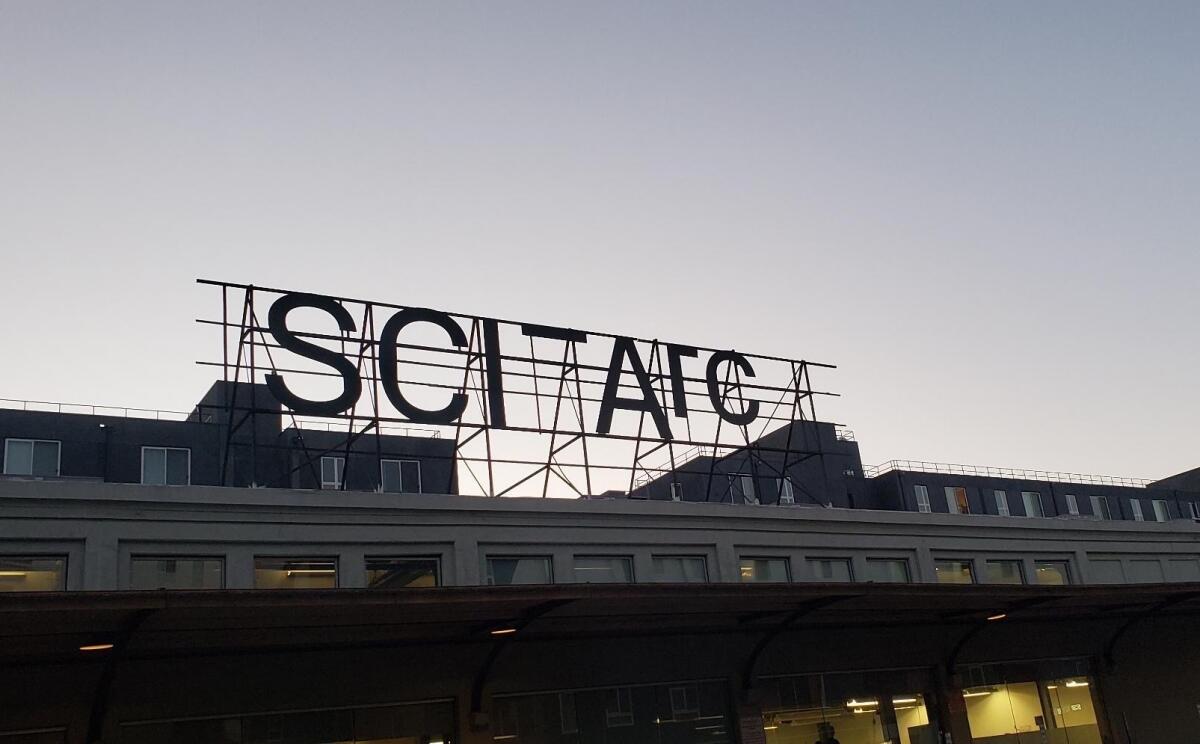
But comments by Trotter about the hours a young architect might face in different settings — she asked students if they preferred “a 40-hour workweek that you can barely get through? Or is it a 60-hour workweek that you can’t wait to start every day?” — along with comments by Griffin about working a “side hustle” set architecture Twitter alight.
On social media, the hashtag #HowNotToBeInAnOffice quickly took off with discussions about labor conditions in a field where long hours, sleepless nights and low pay have long served as a sort of ritual hazing of the young. (Similar to journalism in that way.) Writer Katherine Guimapang followed up with a blow-by-blow of the proceedings on Archinect.
The hubbub over the panel led a group of SCI-Arc students, faculty and alums to launch a petition calling for the removal of Trotter, who oversees the school’s history and theory curriculum, in addition to Tom Wiscombe, chair of the undergraduate program. The pair both work at Wiscombe’s namesake firm, Tom Wiscombe Architecture, and among the allegations leveled against them was that TWA had hired SCI-Arc students to work on projects and then subjected them to mistreatment.
A follow-up story in the Architect’s Newspaper, citing anonymous sources, goes deeper into the allegations — describing 18-hour workdays with no lunch breaks and a request by Wiscombe that students clean the studio, which led them to quit en masse.
Make the most of L.A.
Get our guide to events and happenings in the SoCal arts scene. In your inbox once a week.
You may occasionally receive promotional content from the Los Angeles Times.
The school’s director, Hernán Díaz Alonso, responded by placing Wiscombe and Trotter on administrative leave and announcing that the school was hiring an independent firm to investigate the allegations.
Wiscombe followed up by posting a public apology on his Instagram account. “I’m aware that I often focus too much on design outcomes and not enough on the environment and community that makes it all possible,” he wrote. “I also tend to be hard on myself and I let that hardness extend to others, which is unfair.”
A spokesperson for SCI-Arc tells The Times that the school will appoint new acting undergraduate co-chairs in coordination with faculty representatives and the student union and that acting history and theory coordinators have been selected. “We’ve also created a working group who will reconsider how internships are structured and facilitated at SCI-Arc,” said the representative in an emailed statement, “as well as examine scholarship policies to ensure fair access to funding and professional opportunities.”
Wiscombe and Trotter, in the meantime, will remain on administrative leave until the investigation is complete.
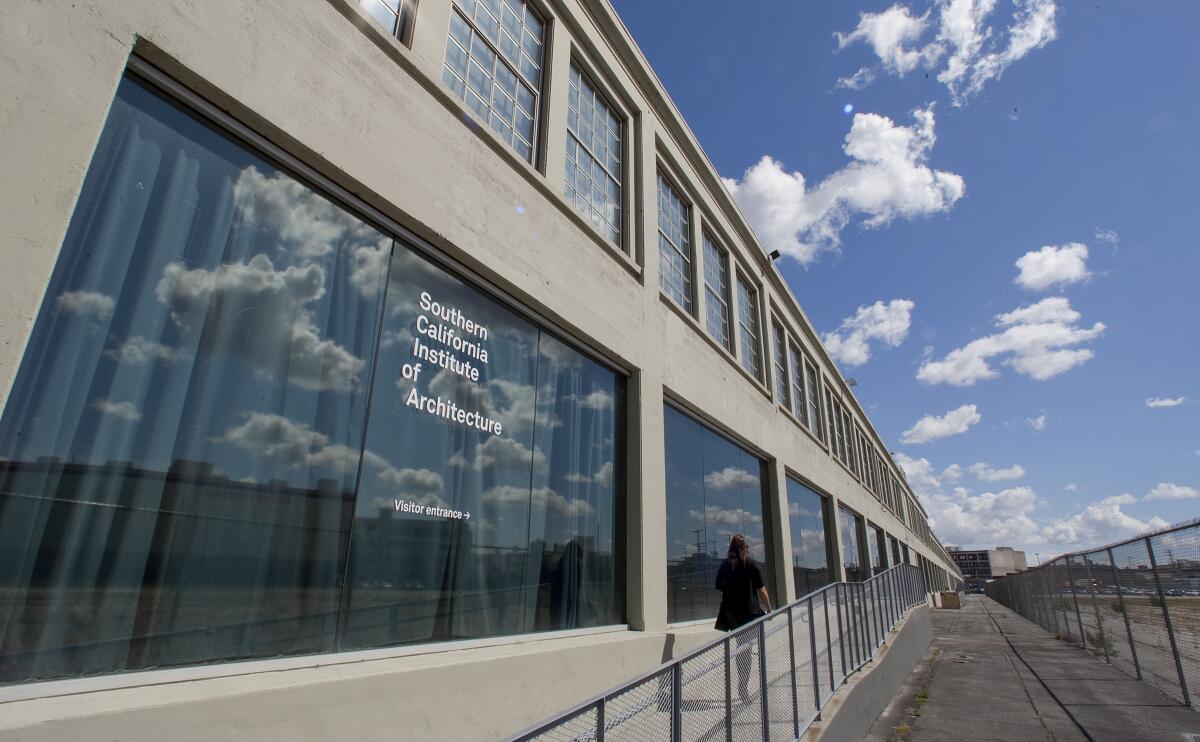
The initial reaction to the panel could be seen as a zillennial overreaction to the musing of old-timers reminiscing about their early days. In my day, we walked to school uphill both ways in the snow while designing service cores on AutoCAD. But the debate about labor practices lands at a time in which labor issues in the architectural field, long rife with phenomena such as unpaid internships, have come under increasing scrutiny.
Employees at SHoP Architects in New York recently led a failed unionization drive over issues related to working conditions at their company. Groups such as the Architecture Lobby, a New York-based nonprofit, have arisen to raise awareness over substandard pay and dire working conditions. One of the tenets of its manifesto: “No more free labor; no unpaid internships, unpaid overtime, or unpaid competitions.”
On social media, the popular, anonymously run Instagram account @dank.lloyd.wright made headlines after drawing attention to a job posting issued by Rem Koolhaas’ Office for Metropolitan Architecture that included among the necessary skills: “no 9-5 mentality.” After being called out, OMA removed that line from its listing.
In an essay on Archinect, architecture writer Sean Joyner examined the profession’s roots in medieval professional systems of apprenticeship. It’s a type of thinking that still pervades many studios: Find an architect you respect, work for them for little to no money while enduring long hours and creative temper tantrums, and maybe one day you too can get ahead in this field.
And that was ultimately the panel’s greatest failure of imagination. As the anonymous figure who goes by the name Hustle Architect wrote in a Substack post: “If contemporary architectural practice is difficult to maintain (it is), if the profession needs new models to adapt to a changing world (it does), if how we work today needs reimagining (undoubtedly), then I would hope to see SCI-Arc leading the charge.”
Here’s hoping they do.
Visual art report
Times art critic Christopher Knight paid a visit to the freshly renovated Museum of Contemporary Art San Diego in La Jolla, which opens to the public on Saturday after an expansive revamp and expansion by Selldorf Architects — and the reinstallation is putting a much-needed spotlight on female artists. “Women’s work,” he writes, “is prominent throughout captivating galleries dedicated to Minimalism and Pop, Light and Space art, Conceptualism, art from Latin America and the San Diego/Tijuana border region, identity politics and more.”
The first temporary show? It’s devoted to Niki de Saint Phalle, the French American artist known for her large, voluptuous figures she called nanas. “The sharply focused exhibition,” writes Knight, “looks terrific.”
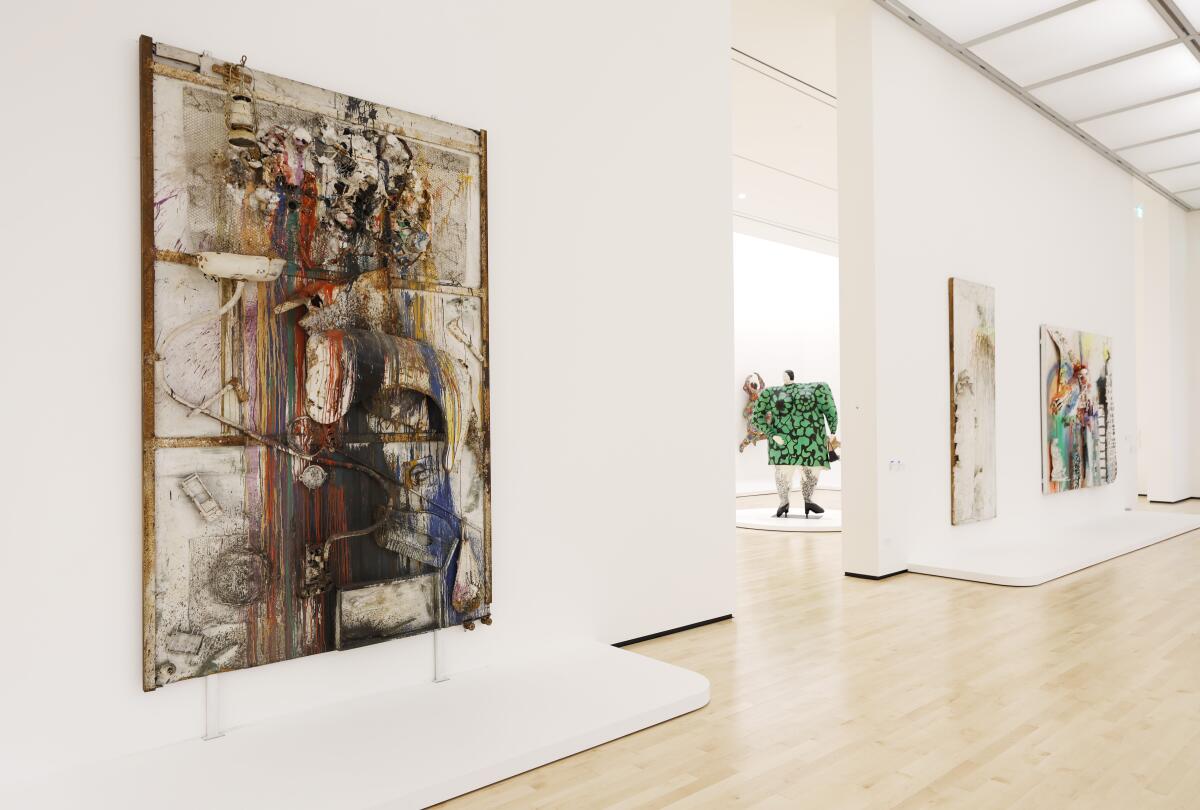
Barbara Kruger has a fantastic solo exhibition on view at LACMA. (Read Knight’s review!) I recently sat down with her for a Q&A where we talked about mass media and her visits to 4chan. “Direct address has always been the motor of my work, whether it’s still or moving,” she says of how different media have informed her work: “Watching the screen — we live in such a screen culture — it’s a direct address culture, if it’s YouTube or Zoom, and besides that, TikTok.”
The Horizon Art Foundation, a new L.A. nonprofit, recently launched a program that brings artists from around the globe to Los Angeles for three-month residencies. Culture writer Deborah Vankin spent some time in the studio with one of the first artists selected: Laurie Kang, an artist whose organic, practically carnal works are made with sheets of film and cast aluminum. The program, says Kang, has “really allowed me to grow and change.”
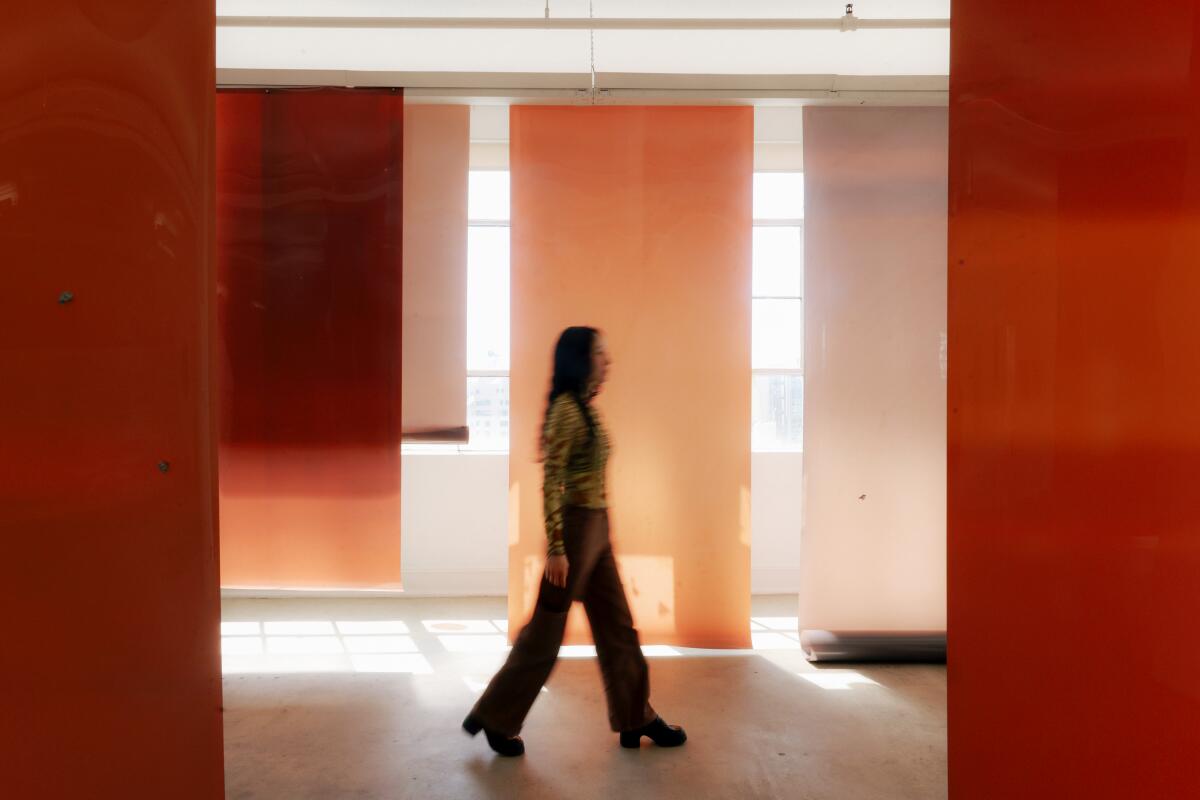
Deaccessioning rules reset
Christopher Knight has been working the phones on the question of whether the Assn. of Art Museum Directors would permanently loosen rules its rules on deaccessioning that went into effect in 2020.
Enjoying this newsletter? Consider subscribing to the Los Angeles Times
Your support helps us deliver the news that matters most. Become a subscriber.
In a mini-dispatch for this newsletter, he writes:
“The controversial two-year moratorium on sanctions of museums using funds raised from selling art from their collections to pay for operations expires on Sunday. The temporary freeze was adopted by the AAMD during the chaotic weeks in spring 2020 when the COVID-19 pandemic erupted.
“In subsequent months, a host of important paintings went to the auction block — many for reasons seemingly unrelated to the financial impact of the health crisis. Multimillion-dollar works by Jackson Pollock, Thomas Cole, Helen Frankenthaler, Lucas Cranach the Elder and other celebrated artists disappeared from public into private collections. An AAMD spokesperson confirmed that the long-standing ban on monetizing art museum collections to pay bills will return starting April 10.”
Classical notes
The Los Angeles Master Chorale recently won a Grammy for a recording of Mahler’s Eighth Symphony (in a performance led by Gustavo Dudamel), and that is just one of a string of reasons why the choir, which was formed in 1964, is an essential part of the Los Angeles musical landscape, writes Times classical music critic Mark Swed. On Music Director Grant Gershon’s 20th anniversary with the choir, Swed reports that the Chorale is “the finest-by-far major chorus in America and one able to serve exceptionally wide needs.”

On and off the stage
In his work, playwright Lucas Hnath has taken on the lives of Isaac Newton and Bill and Hillary Clinton. Now, reports Times theater critic Charles McNulty, he has set his sights on Walt Disney. Hnath’s 2013 play, “A Public Reading of an Unproduced Screenplay About the Death of Walt Disney,” is receiving its West Coast premiere in a Working Barn Productions presentation at the Odyssey Theatre. It’s imagined as a reading about Disney’s life written by Disney himself. Says McNulty: “Embedded in an experimental comedy is the tale of a tragic overreacher, a mortal who has come to assume a godlike dominion over the rest of the planet.”
Richard Greenberg’s Tony-winning “Take Me Out,” a play about a pro ballplayer who comes out as gay, has once again landed on Broadway. Times contributor Stuart Miller speaks to the show’s stars, Jesse Williams and Patrick J. Adams, about what the project means to them. Says Williams of returning to the stage after the pandemic’s interruption: “When we returned two years later, I felt more emotionally mature and available. The character just sat there but I’ve grown and now see some of my own BS more clearly.”

South Coast Repertory is staging a production of “Clean/Espejos,” a new work by playwright Christine Quintana. Set in Mexico, this bilingual play captures a poignant social intersection: that of a U.S. guest at a fancy Mexican resort and a local woman who works there. As Quintana tells Times contributor Nikki Munoz: “I felt a lot of friction and thought about the whole idea of the resort being a fantasy of Mexico provided by these big, mostly American-owned resort companies.”
Plus, Robert Abele reviews Valérie Lemercier’s new movie musical, “Aline,” inspired by the life of singer Celine Dion. It’s an eccentric, “flippin’ weird” film, he writes, one in which “the swoop of its romanticism and oddness can sometimes seem like you’re eavesdropping on the private role-playing of a worshipful schoolgirl in a poster-lined bedroom.” Film writer Jen Yamato talks with Lemercier about playing her homage to Dion from age 5 to 50.

Essential happenings
Matt Cooper has the six best bets for weekend culture in L.A., including a day of new music courtesy of the L.A. Phil and a performance by the Alvin Ailey American Dance Theater at the Dorothy Chandler Pavilion.
I caught the troupe’s first L.A. performance on Wednesday, an ebullient show after the long pandemic absence. The program featured a mixed repertory that pays tribute to Robert Battle‘s decade as artistic director and a performance of Ailey’s “Revelations,” from 1960, which featured dance set to African American spirituals and the blues. I was particularly taken with the excerpt of Canadian choreographer Aszure Barton’s “Busk,” in which the dancers, dressed in austere gray hoodies, come together in what appears to be a single body.
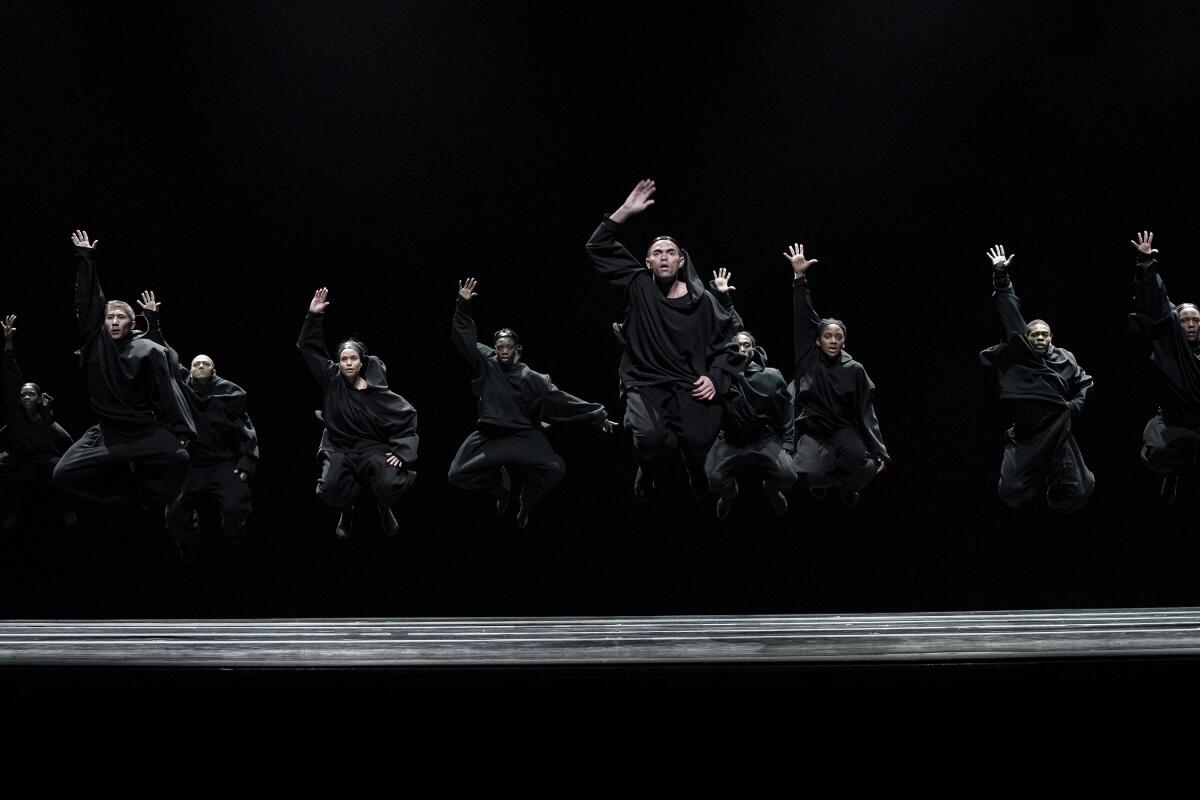
Alvin Ailey American Dance Theater will be onstage at the Dorothy Chandler through Sunday, musiccenter.org.
Moves
NYU Provost Katherine E. Fleming has been named the new president and CEO of the J. Paul Getty Trust — putting a woman in charge of one of the most affluent cultural organizations in the country, reports The Times’ Deborah Vankin.
Arts nonprofit LAXART, which has long inhabited a rented space in Hollywood, has acquired a building in East Hollywood and plans to relocate in the fall. “A permanent home gives us the opportunity to reimagine what an alternative art space can be,” LAXART Director Hamza Walker said in a statement to Vankin.
Administrators at UC Irvine have chosen a location for the Jack and Shanaz Langson Institute and Museum of California Art on Campus Drive near Jamboree Road in Irvine. Now that the location has been chosen, the next step will consist of choosing an architect and setting budgets. IMCA, in the meantime, has been operating out of a temporary space, which will reopen to the public in June.
Ojai Playwrights Conference Artistic Director and producer Robert Egan is stepping down at the end of 2022, reports Charles McNulty. Egan, who has led the organization for 21 years, has helped make Ojai one of the preeminent centers of new play development in the U.S.
Passages
Patrick Demarchelier, a French-born photographer known for his high-fashion images, as well as for iconic images of celebrities such as Princess Diana, has died at 78.
Joseph Kalichstein, an Israeli American pianist whose playing embodied delicacy and precision, is dead at 76.
Mira Calix, a composer who worked on orchestral commissions and theater scores, as well as public art installations and live DJ sets of electronica, has died at 52.
In other news
— Tokyo’s Nakagin Capsule Tower, the landmark Metabolist building designed by Kisho Kurokawa, is set to be demolished starting April 12.
— Community Art Project, an arts nonprofit in Laguna Beach, has ended a partnership with a local Wells Fargo branch after customers complained about Black Lives Matter-themed quilts.
— How Indigenous dancers are creating new fusions of traditional dance and hip-hop.
— Italian ballet dancer Jacopo Tissi has returned to Milan’s La Scala after departing the Bolshoi in the wake of the Russian invasion of Ukraine.
— Meanwhile, the Bolshoi Theatre staged a performance in support of the families of Russian soldiers.
— Faced with war, Ukrainian fashion designers are crafting gear for the Ukrainian military, such as camouflage nets and military vests.
— How a mural of two DJs in Belarus became a symbol of anti-autocratic resistance.
— New word: synanthropes.
And last but not least ...
Two words: Dua Lipone.
The biggest entertainment stories
Get our big stories about Hollywood, film, television, music, arts, culture and more right in your inbox as soon as they publish.
You may occasionally receive promotional content from the Los Angeles Times.




